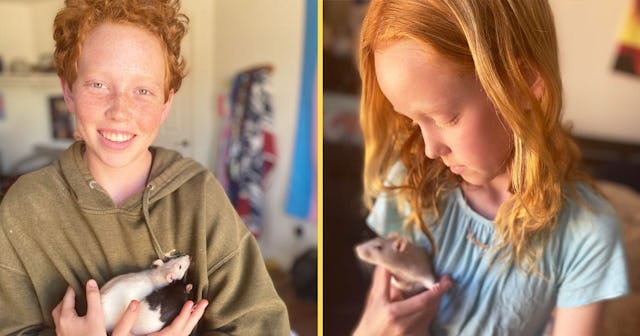Some People Are Adopting Dogs During The Pandemic -- But We Adopted Rats

My husband and I are dog people. More specifically, we are Labrador Retriever people. Our chocolate lab worships my husband and our yellow lab adores my twelve-year-old son. Though my nine-year-old daughter loves the dogs too, she has been begging for an animal — any animal — of her own.
“What about a goat, Mom?” she asks.
“Reptiles are a non-starter,” my husband, who loathes anything slithery, warns.
Cats are out — I’m allergic.
Here in suburbia, that leaves us with the wee critters — guinea pigs, hamsters, rabbits, and rats.
Guinea pigs are friendly and social but they’re on the bigger side, and since they produce a fair amount of smelly waste, their cage needs to be cleaned daily. That’s a lot, even for our responsible daughter, to handle.
Hamsters are cute and clean but prone to biting. It’s not entirely their fault; they have bad eyesight. Plus, they’re nocturnal — an animal that runs on a wheel much of the night is not ideal for my light sleeper’s bedroom.
Rabbits are super cute, soft, and snuggly, and their droppings aren’t smelly. But because they have delicate digestive systems and need movement and hay at all times in order to stay healthy, they require a large enclosure — ideally an entire room — to roam in 24/7. They will also chew up electrical cords, your favorite shoes, and that new Wayfair purchase. Also, they don’t always get along with other animals. I heard a bunny growl at a dog once. The dog fled in terror.
So that leaves rats. Shudder, right? But actually, pet rats (also called fancy rats) are as different from wild rats as dogs are from wolves. In fact, fancy rats are considered the dogs of the rodent world, since they will learn tricks, learn their names, and come when called!
Courtesy of Rachel Lyons
Pet rats don’t smell, and they use a cardboard litter box in their cage that you replace once or twice a week. It doesn’t get any easier than that. Their lifespan is two to three years, which is not exactly an overwhelming commitment. To some, though, no matter how intelligent, clean, friendly, cute, adaptable, and low maintenance they are, they’re still rats. And that tail.
Take a look at the “ratfluencers” on #ratsofinstagram. Cute, right? Ratteries breed and sell fancy rats in every color, coat type, marking, and body type imaginable. We emailed a local breeder and the first question she asked was whether we wanted a pet or a show rat. (Yes, showing rats is a thing!) There are hairless fancy rats, Dumbo fancy rats (the ears!), even Manx (tailless) fancy rats. You can buy or adopt a Russian Blue Berkshire Dumbo rex (curly-haired) rat, if you desire.
Courtesy of Rachel Lyons
Apparently, Southern California, where we live, is the fancy rat capital of the world. There are eight (!) ratteries within a short drive. I figured I’d visit one, let the kids pick out a rat, and, voilà, new pet.
Ha!
First of all, you don’t adopt one rat. They are sold in same-sex pairs. (Never buy a mixed-sex pair, unless you have aspirations of getting into the rattery business.) Rats are highly social animals and, in most cases, it’s cruel to keep them in solitary confinement. They share food, play wrestle, and snuggle up together in a hammock to sleep. It’s pretty dang cute.
Second, ratteries have waiting lists with fees and contracts, and your family is vetted the way it would be if you wanted to adopt a dog from a shelter or breeder. We were told it could be weeks or months to adopt from one of our local ratteries.
Courtesy of Rachel Lyons
We looked on Craigslist but were concerned that sellers on that site were not necessarily experts in identifying rat genitalia. Buying from pet shops is not recommended either. Their rats may not be handled enough to make good pets.
Luckily, we have a fantastic rescue nearby. Wee Companions has a storefront (and a Facebook page) but all the animals they rescue (guinea pigs, rabbits, hamsters, fancy rats, and even chinchillas) are fostered. There will always be people who buy animals without fully understanding the requirements of caring for them or the consequences of putting male and female animals into an enclosure together.
When we visited one of the organization’s foster moms, she had four baby male fancy rats and two young females for us to choose from. My kids fell in love with five-month-old sisters who had been given up weeks before. These were curious, affectionate, calm, and, yes, adorable creatures who skittered across my children’s shoulders and necks, tickling their ears with their white whiskers and eventually curling up to sleep in the hoods of their sweatshirts as the foster mom explained everything we needed to know about their care and feeding.
All of the supplies (a 3′ x 2′ x 3′ cage, food and bedding for three months, hammocks, a wheel, and water bottle) can be had for less than $300 online, and your local rescue might offer discounts. The adoption fee was $20 for two rats. Their food (pellets) is inexpensive, and they love fruit (no citrus), cooked starchy veggies, chicken and chicken bones, and loads of other foods as treats.
The hours my kids have spent caring for, loving, and building cardboard play areas for their new pets (and off devices) is priceless. Two years with them won’t be nearly long enough.
This article was originally published on